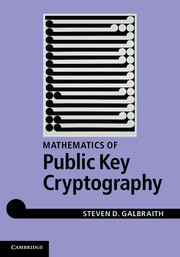Book contents
- Frontmatter
- Contents
- Preface
- Acknowledgements
- 1 Introduction
- PART I BACKGROUND
- PART II ALGEBRAIC GROUPS
- PART III EXPONENTIATION, FACTORING AND DISCRETE LOGARITHMS
- PART IV LATTICES
- PART V CRYPTOGRAPHY RELATED TO DISCRETE LOGARITHMS
- 20 The Diffie–Hellman problem and cryptographic applications
- 21 The Diffie–Hellman problem
- 22 Digital signatures based on discrete logarithms
- 23 Public key encryption based on discrete logarithms
- PART VI CRYPTOGRAPHY RELATED TO INTEGER FACTORISATION
- PART VII ADVANCED TOPICS IN ELLIPTIC AND HYPERELLIPTIC CURVES
- Appendix A Background mathematics
- References
- Author index
- Subject index
23 - Public key encryption based on discrete logarithms
from PART V - CRYPTOGRAPHY RELATED TO DISCRETE LOGARITHMS
Published online by Cambridge University Press: 05 June 2012
- Frontmatter
- Contents
- Preface
- Acknowledgements
- 1 Introduction
- PART I BACKGROUND
- PART II ALGEBRAIC GROUPS
- PART III EXPONENTIATION, FACTORING AND DISCRETE LOGARITHMS
- PART IV LATTICES
- PART V CRYPTOGRAPHY RELATED TO DISCRETE LOGARITHMS
- 20 The Diffie–Hellman problem and cryptographic applications
- 21 The Diffie–Hellman problem
- 22 Digital signatures based on discrete logarithms
- 23 Public key encryption based on discrete logarithms
- PART VI CRYPTOGRAPHY RELATED TO INTEGER FACTORISATION
- PART VII ADVANCED TOPICS IN ELLIPTIC AND HYPERELLIPTIC CURVES
- Appendix A Background mathematics
- References
- Author index
- Subject index
Summary
Historically, encryption has been considered the most important part of cryptography. So it is not surprising that there is a vast literature about public key encryption. It is important to note that, in practice, public key encryption is not usually used to encrypt documents. Instead, one uses public key encryption to securely send keys, and the data is encrypted using symmetric encryption.
It is beyond the scope of this book to discuss all known results on public key encryption, or even to sketch all known approaches to designing public key encryption schemes. The goal of this chapter is very modest. We simply aim to give some definitions and to provide two efficient encryption schemes (one secure in the random oracle model and one secure in the standard model). The encryption schemes in this chapter are all based on Elgamal encryption, the “textbook” version of which has already been discussed in Sections 20.3 and 20.4.
Finally, we emphasise that this chapter only discusses confidentiality and not simultaneous confidentiality and authentication. The reader is warned that naively combining signatures and encryption does not necessarily provide the expected security (see, for example, the discussion in Section 1.2.3 of Joux [283]).
CCA secure Elgamal encryption
Recall that security notions for public key encryption were given in Section 1.3.1. As we have seen, the textbook Elgamal encryption scheme does not have OWE-CCA security, since one can easily construct a related ciphertext whose decryption yields the original message.
- Type
- Chapter
- Information
- Mathematics of Public Key Cryptography , pp. 469 - 482Publisher: Cambridge University PressPrint publication year: 2012



